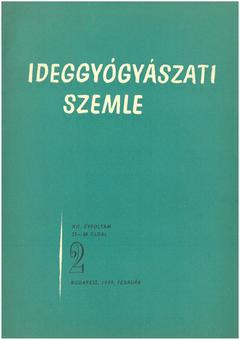The eLitMed.hu medical portal uses computer cookies for convenient operation. Detailed information can be found in the Cookie-policy.
Clinical Neuroscience - 1959;12(02)
Content
[Ethical considerations in neuro- and mental medicine ]
[From the problems discussed, it is clear that for doctors in general, and neurologists and psychiatrists in particular, not only is professional competence important, but perhaps even more important - ethical purity! Mistakes can be made, and we cannot be completely insured against them. But it is an inexcusable sin to knowingly misrepresent oneself in the service of individual interests. In guiding our actions, conscience plays a leading role, dictating our actions and enabling us to take the elevated view that 'duty before interest, honour before money' ('le devoir avant l'intérêt, l'honneur avant l'argent', Desfosses). The doctor's role is facilitated by the fact that people are not to be judged by their spiritual worth, material possessions or social position, but solely by their suffering. This basis enables him to develop to an artistic height not only the noble feelings of understanding, compassion and sympathy, but also those of selfless help. ]
[Connected to the tetraaethylthyuram disulphide treatment psychiatric analysis of exogenous psychoses]
[To summarise our clinical cases, we can identify two groups of psychiatric phenomena that occur during TATD treatment. The first group includes psychic phenomena that coincide with vegetative symptoms, such as drowsiness, erythema, pain, mood instability, etc. The second group of psychic phenomena takes a very varied form, and the following forms of psychosis were identified: 1. mood disturbance, which may take the form of depression or mania, or a "mixed" form as a separate TATD alcohol psychosis; 2. disturbance of consciousness manifested as mild "benommenheit" or simple tenebrositas in the Kleistian sense, or as a perplexed tenebrositas, or as a rarely observed hallucinatory foggy state; 3. in the context of alcohol treatment for TATD, ecstatic states similar to the image described by Müller-Freienfels as "Rausch" may occur; 4. hypnagogic hallucinations in other cases ; 5. delirium tremens or 6. amentiform images may occur. The paradoxical thirst for alcohol that develops during "drink body" treatment may be seen as an interesting complication. ]
[Extinction as a disruption of the cooperation between specific and non-specific afferent systems]
[The author lists the physiological and pathological conditions under which extinction is observed. He reviews data on specific and non-specific afferent system cooperation. The theory is presented that pathological extinction is caused by a combined impairment of the specific and non-specific afferent system. Diffuse dysfunction of nonspecific afferents results in extinction with generalized attention deficit and rostral dominance. Co-injury of the thalamocortical specific and non-specific fibrous system causes localized attention deficit and localized extinction in the contralateral hemisphere. Both physiological and pathological extinctio show rostral dominance. The rostral dominantia is explained by bilateral cortical representation of the face and the special wakefulness of trigeminal impulses. In pathological extinction, a dysfunction of the sensory system can be detected even when no sensory dysfunction is found by routine tests. Even in such cases, a threshold elevation and a shortening of the sensory adaptation time are always detectable. The adaptation time shows the greatest degree of shortening in cases of combined damage to specific and non-specific systems. ]
1.
Clinical Neuroscience
[Headache registry in Szeged: Experiences regarding to migraine patients]2.
Clinical Neuroscience
[The new target population of stroke awareness campaign: Kindergarten students ]3.
Clinical Neuroscience
Is there any difference in mortality rates of atrial fibrillation detected before or after ischemic stroke?4.
Clinical Neuroscience
Factors influencing the level of stigma in Parkinson’s disease in western Turkey5.
Clinical Neuroscience
[The effects of demographic and clinical factors on the severity of poststroke aphasia]1.
2.
Clinical Oncology
[Pancreatic cancer: ESMO Clinical Practice Guideline for diagnosis, treatment and follow-up]3.
Clinical Oncology
[Pharmacovigilance landscape – Lessons from the past and opportunities for future]4.
5.



